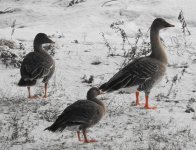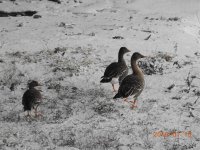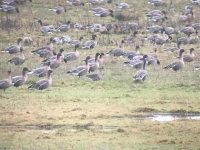-
Welcome to BirdForum, the internet's largest birding community with thousands of members from all over the world. The forums are dedicated to wild birds, birding, binoculars and equipment and all that goes with it.
Please register for an account to take part in the discussions in the forum, post your pictures in the gallery and more.
You are using an out of date browser. It may not display this or other websites correctly.
You should upgrade or use an alternative browser.
You should upgrade or use an alternative browser.
Tundra or Taiga bean goose (1 Viewer)
- Thread starter marius.k
- Start date
More options
Who Replied?Nutcracker
Stop Brexit!
Front bird is a juvenile Greater Whitefront - both the other two are quite large by comparison, so perhaps both Taiga?
Dougie Preston
I live for this S**T
Both the geese in question are Tundra. They lack the Swan like neck proportions of Taiga, and the bill looks too delicate. Bill pattern also favours Tundra (mostly back with orange band near the tip).
phil baber
Clipped Wing

Both the geese in question are Tundra. They lack the Swan like neck proportions of Taiga, and the bill looks too delicate. Bill pattern also favours Tundra (mostly back with orange band near the tip).
Agree with Dougie here. We used to call then rossicus... :cat:
PS Like a Pinkfoot, but a bit Bean-erer!
Last edited:
Nikolai Kolev
Well-known member
Join Date: Sep 2016
Location: Radnevo; Bulgaria
Posts: 72
https://www.birdforum.net/showthread.php?t=37199
I have the similar question, and nobody anser me.
Location: Radnevo; Bulgaria
Posts: 72
https://www.birdforum.net/showthread.php?t=37199
I have the similar question, and nobody anser me.
And according to IOC v8.2, "we" still do ...Agree with Dougie here. We used to call then rossicus... :cat:
Join Date: Sep 2016
Location: Radnevo; Bulgaria
Posts: 72
https://www.birdforum.net/showthread.php?t=37199
I have the similar question, and nobody anser me.
Hi Nikolai. Your link doesn't work. Here's the correct link to your earlier post.
I would have said Tundra for your birds because of the stubby bill shape and short neck. But I'm no expert.
Good joke, by the way!
Nutcracker
Stop Brexit!
Currently Anser serrirostris rossicus :t:And according to IOC v8.2, "we" still do ...
But I'd not be surprised if it all changes again once a full analysis of the eastern Asian subspecies is done . . .
Joern Lehmhus
Well-known member
By the size of the birds compared to the Whitefront and especially the bill shape of the front bird I get more a Taiga bean goose feel especially for the front bird- but they do not appear as longnecked as I´d be used to. In this respect they are more Tundra like, as well as the slightly differntly appearing bill of the 2nd bird. And we do not know if the whitefront was a very small individual.
I think these birds are well within the variation of what Tundra Bean Geese look like. They don't look exceptionally large to me, and all other characteristics (bill shape/colour, body structure, neck length, head shape, rather greyish brown color) all point towards this species.
I think the birds that Nikolai wanted an opinion on are not 100% identifiable from those pictures, although I am leaning towards Tundra Bean Goose for these too, given that they appear rather short-necked. The orange bill colour may be slightly more extensive than people expect for this species, but this is not a very useful identification criterion in my experience. I would assume Tundra Bean Goose is also the much more likely species to occur in Bulgaria?
Lutzen Portengen
I think the birds that Nikolai wanted an opinion on are not 100% identifiable from those pictures, although I am leaning towards Tundra Bean Goose for these too, given that they appear rather short-necked. The orange bill colour may be slightly more extensive than people expect for this species, but this is not a very useful identification criterion in my experience. I would assume Tundra Bean Goose is also the much more likely species to occur in Bulgaria?
Lutzen Portengen

I agree that Anser serrirostris rossicus is most parsimonious. Here is a source that is used to separate the species in the Far East:
Masayuki, K. et al. 1983. Notes on the Field Identification of Anser fabalis serrirostris and A. f. middendorfi. Tori 32:95-108. (PDF)
In summary, the two can be separated by a combination bill and head structure alone. A few birds that key out to be Taiga but which seem too small are not considered identifiable at this time. They may be hybrids. And FWIW, I think the split into two species was premature at best.
Masayuki, K. et al. 1983. Notes on the Field Identification of Anser fabalis serrirostris and A. f. middendorfi. Tori 32:95-108. (PDF)
In summary, the two can be separated by a combination bill and head structure alone. A few birds that key out to be Taiga but which seem too small are not considered identifiable at this time. They may be hybrids. And FWIW, I think the split into two species was premature at best.
Not sure to what extent criteria suggested for separating serrirostris from middendorffii are useful in a European context, to me fabalis and middendorffii look quite different (although I have no field experience with the latter). I have no strong opinion with regards to species status for Taiga and Tundra Bean Geese (and/or Middendorf's Goose), but I would personally not give too much weight to the fact that some individuals can not be safely identified.
Lutzen
Lutzen
Stuart Darbyshire
45th generation Northern

I would assume Tundra Bean Goose is also the much more likely species to occur in Bulgaria?
Lutzen Portengen
I think your assumption is correct Lutzen.
Chris
Similar threads
- Replies
- 1
- Views
- 637
Users who are viewing this thread
Total: 2 (members: 0, guests: 2)







